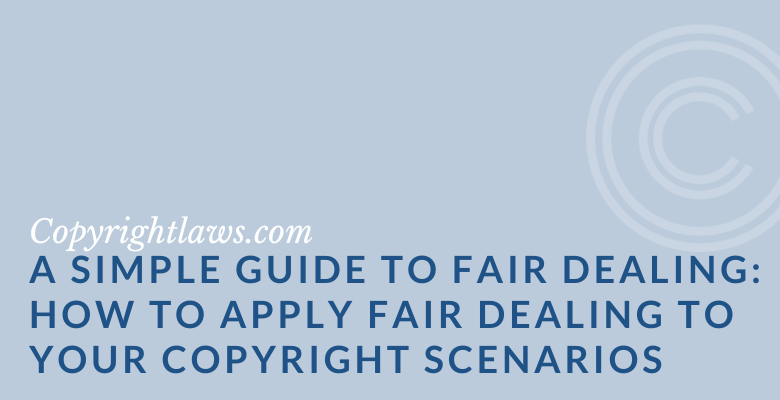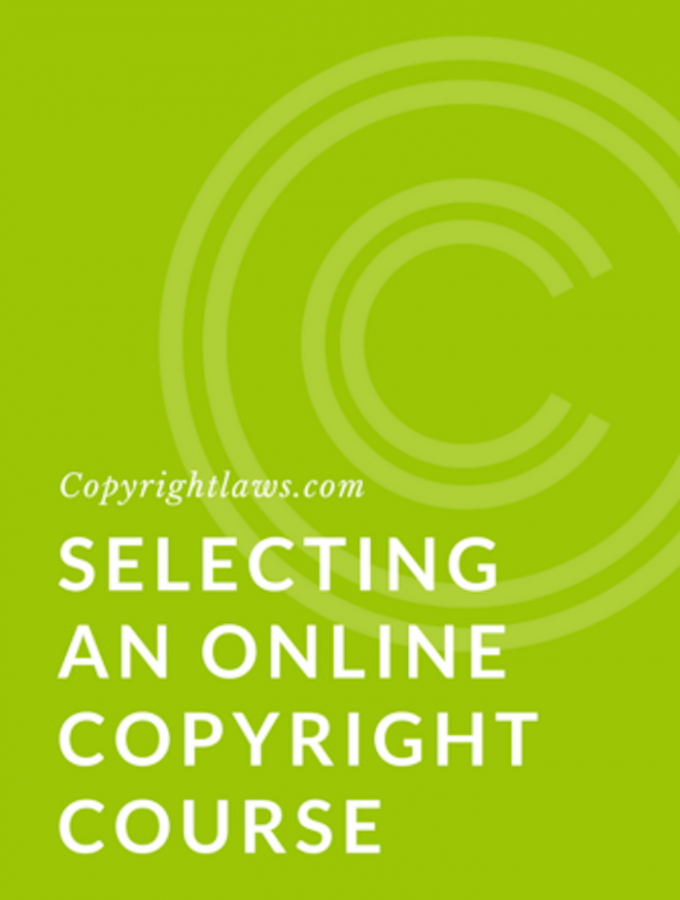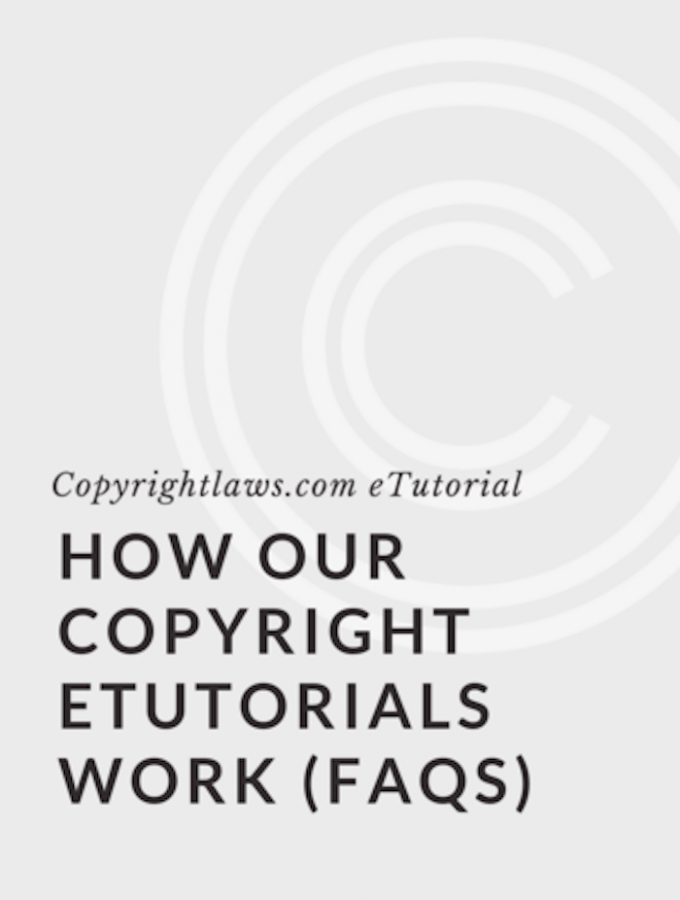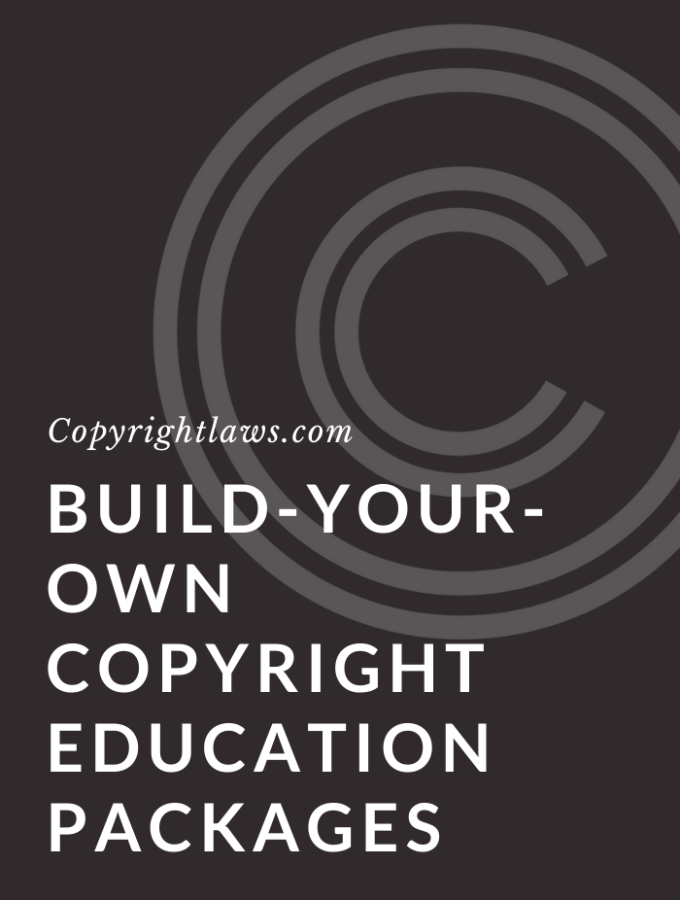
Understanding fair dealing in Canadian copyright law is essential for anyone using copyright-protected materials. Fair dealing is intentionally ambiguous, and it can be overwhelming to apply it to your own situations. Inform yourself about the facts of fair dealing and how it works. Be an educated decision maker when determining whether fair dealing applies to your specific circumstances. This article provides essential information that you can immediately apply to your own situations and fair dealing analyses.
As a bonus, use this form to download the PDF A Simple Guide to Fair Dealing: How to Apply Fair Dealing to Your Copyright Scenarios.
If the form above doesn't work, please follow this link to sign up.
Quick Navigation to A Simple Guide to Fair Dealing
- Applying Fair Dealing Is a Judgment Call
- Fair Dealing in Canadian Copyright Law is Intentionally Ambiguous
- Fair Dealing Purposes and Factors
- Fair Dealing Resources
- Does Fair Dealing Apply Outside Canada?
- Five Essential Facts About Fair Dealing
Applying Fair Use Is a Judgment Call
You don't need to be a copyright law expert or a lawyer to understand fair dealing. What deters people from applying fair dealing to their circumstances is that this principle isn't clear-cut. It requires an analysis and application of the fair dealing factors to each set of circumstances.
Be aware, however, that the application of fair dealing in Canadian copyright law is never a certain thing unless a judge in a court of law makes that fair dealing determination.
You’ll need to become comfortable with the basics of fair dealing and making judgment calls on applying it to your particular use of copyright-protected materials. Applying fair dealing also requires understanding copyright risk management so you can minimize your risk of copyright infringement.
Fair Dealing in Canadian Copyright Law Is Ambiguous
A common misconception about fair dealing in Canada is that it is a recent edition to Canadian copyright law. In fact, the concept of fair dealing can be traced back to 18th century English case law. It was then codified into Canadian Copyright Law in 1921, which makes it older than the law related to the U.S. concept of fair use (which was codified and set out in law through the 1976 U.S. Copyright Act).
In the Canadian Copyright Act, fair dealing was initially included as section 16.1(i) and originally covered the purposes of private study, research, criticism, review, or newspaper summary. The purposes of parody, satire and education were added to the Actin 2012.
Many complain that fair dealing is ambiguous. But the definition of fair dealing is intentionally open and flexible. Its language allows you to apply the doctrine to a wide variety of circumstances. And you must review the particular facts of each situation when applying fair dealing to it.
Some organizations institute a policy to prohibit the application of fair dealing because of its uncertain nature and the need to analyze each fair dealing situation. Other organizations designate key people (e.g., a copyright specialist or librarian) to make all fair dealing application decisions. Others allow individuals to make their own fair dealing determinations, while still others require a consultation with legal counsel. Know your organization’s position on applying fair dealing.
Fair Dealing Purposes and Factors
Fair dealing in Canadian copyright law may be applied by individuals and corporations, by commercial and non-commercial entities, and in for-profit and non-profit situations. It all depends on the facts of your situation and how these facts fit within the six fair dealing factors.
As mentioned above, Section 29 of the Canadian Copyright Act states that the fair dealing of a copyrighted work isn't an infringement of copyright, for purposes such as:
- Research
- Private Study
- Education
- Parody
- Satire
- Criticism
- Review
- News Reporting
The Copyright Act is intentionally vague on what counts as “fair” but there has been plenty of guidance on how to interpret this term through the many related court cases over the past few decades. Notably, in its 2004 decision in the case of CCH Canadian Ltd. v. Law Society of Upper Canada, the Supreme Court outlined the six non-exhaustive factors with which to determine the fairness of a use:
1. The purpose of the dealing (i.e., Does it fit one of the listed purposes in the Copyright Act?)
2. The character of the dealing
3. The amount of the dealing
4. The nature of the work
5. The effect of the dealing
6. Alternatives to the dealing
For criticism, review and news reporting, the Act lists specific elements which must be mentioned for the use to be non-infringing.
Take the time to read the exact wording of the fair dealing provision in the Copyright Act as well as some of the numerous guides available explaining the six factors. You'll find these a great starting point for understanding fair dealing.
Understanding the Fair Dealing Factors
You'll need a deeper understanding of each of the six fair dealing factors to apply it to your situations. Here are some tips:
- Purpose of the dealing — Though much about fair dealing is left ambiguous in the Copyright Act, the law does lay out a specific list of purposes which qualify for this provision. Your first step in determining whether your particular use might fall under fair dealing would be to ensure that it is for one of these listed purposes: research, private study, education, parody, satire, criticism, review and/or news reporting.
- Character of the dealing — Often this factor hinges on the size of the dealing. For example, if multiple copies of a work are widely distributed, this use is less likely to be considered fair. However, if you’re using a single copy of the work for a particular purpose (see above), this would be easier to argue as fair.
- The amount of the dealing — Both the extent of the portion used and its quality — whether the copied portion constitutes the “heart” of the total work — are relevant. The Act doesn't set out a threshold level of amount or substantiality. For example, the Act doesn't state that using three percent or ten percent of a work constitutes fair dealing. If the amount you use is quite small in relation to, or insignificant in the context of, the entire source work, then it's more likely to be fair dealing. However, in certain circumstances it may be possible to deal fairly with an entire work.
- Alternatives to the dealing — If there is a work in the public domain or whose use is otherwise unrestricted that could have been used instead of the protected one, this will be considered in determining whether the dealing was fair.
- Nature of the work — This is not often a huge factor in determining if a dealing is fair, but it can be important if the work in question was never intended for publication and therefore the unauthorized dissemination of it is clearly less than fair.
- Effect of the dealing on the work — If the new work which reproduces the original protected work is found to be competing in the same market as the original work, the dealing is likely to be considered less fair. However, note that this is simply one of the factors to be considered and not the most important one. This is sometimes interpreted to mean that any commercial use cannot be considered fair dealing, which is, in fact, not the case.
See all Copyrightlaws.com’s free downloadable Simple Guides to Copyright.
Fair Dealing Resources
Unlike in the U.S. where the Copyright Office provides a free Fair Use Index to help users better understand how their four factors apply to specific situations, the Canadian Intellectual Property Office does not currently have a similar tool. However, that does not mean there are no useful resources out there! Thankfully, most educational institutions and libraries have created fair dealing guidelines that are freely available online and may be helpful to you depending on your situation. We’ve listed a few below but bear in mind that this list is by no means exhaustive, nor will the guidelines provided apply to every situation. When in doubt, consult your own institution’s fair dealing guidelines (if applicable) or seek legal advice.
Fair Dealing Basics – Copyright Office – Dalhousie University
Images: Copyright, Licenses and Fair Dealing – MacOdrum Library
Fair Dealing – Council of Ministers of Education, Canada
Copyright and Fair Dealing – Documentary Organization of Canada
Does Fair Dealing Apply Outside of Canada?
In the close to 200 countries that are members of the Berne Convention, the leading copyright treaty, international copyright law works by applying the law of the country where you're using a work.
Therefore, whether you're reproducing an image from Canada, the U.S., or France, you apply Canadian law if the reproduction takes place in Canada, meaning that you could apply the principle of fair dealing. If the reproduction takes place in France, then you apply French copyright law, and the principles set out in the French copyright act.
Five Essential Facts About Fair Dealing
To effectively apply fair dealing in Canadian copyright law to your situations, you will need to understand as much as you can about this doctrine, read court decisions about fair dealing, and gain practice in applying fair dealing to different scenarios.
The following five essential facts will help guide you through the fair dealing maze.
1. Fair dealing has been defined largely through court cases.
While fair dealing in the Copyright Act is simply defined as a use which falls under the specified categories (research, private study, education, parody, satire, criticism, review and/or news reporting), the Act is intentionally vague on what counts as “fair.” However, there has been plenty of guidance on how to interpret this term through the many related court cases over the past few decades. Notably, in its 2004 decision in the case of CCH Canadian Ltd. v. Law Society of Upper Canada, the Supreme Court outlined the six non-exhaustive factors with which to determine the fairness of a use. These factors were then reasserted in a set of decisions in 2012. More on these factors below!
2. Fair dealing may apply to a variety of purposes.
Section 29 of the Canadian Copyright Act states that, “fair dealing for the purpose of research, private study, education, parody or satire does not infringe copyright.” Criticism, review and news reporting are also mentioned as acceptable uses as long as the source of the material is named. However, as these various uses are not clearly defined, it is often a judgment call as to whether the use of a work falls into one of these categories.
3. There are six factors to consider when determining if fair dealing applies.
Fair dealing depends on the facts of your situation and how they fit within the six non-exhaustive factors laid out in the Supreme Court’s decision mentioned above. The six fair dealing factors are:
- Purpose
- Character
- Amount
- Alternatives
- Nature
- Effect
4. The ultimate determinant of fair dealing is a judge in a court of law.
Fair dealing is never a certain thing unless a judge in a court of law makes that determination. It’s important to get comfortable with making fair dealing judgment calls, and to understand copyright risk management and your enterprise’s position on fair dealing. Many educational institutions now have fair dealing guidelines, and your organization may already have some as well!
5. Fair dealing applies to all users and both for- and non-profit situations.
Fair dealing applies to all users of content. It may apply in commercial or for-profit situations as well as non-profit situations. It’s less likely that you can claim fair dealing in for-profit situations, but it’s still possible. And not all non-profit uses of content are fair dealing.
Fair dealing decision making and lowering copyright infringement risks are key parts of our Certificate in Canadian Copyright Law online program.
If the form above doesn't work, please follow this link to sign up.



